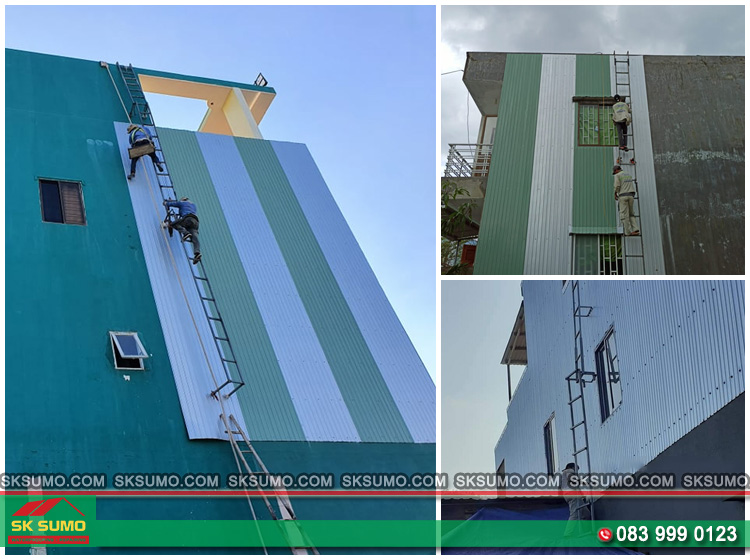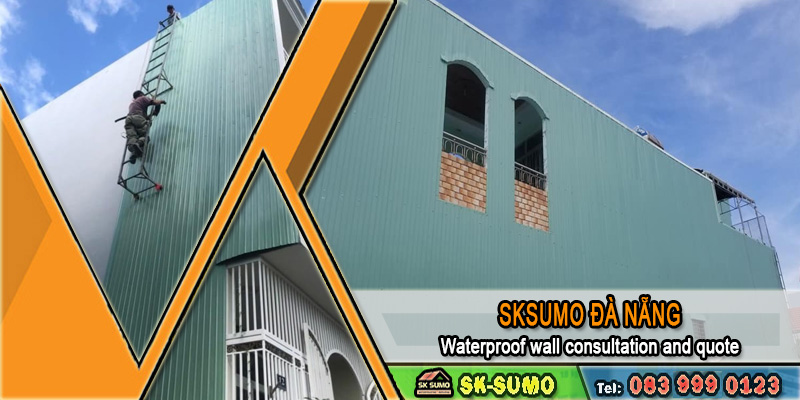Water seepage through walls not only affects aesthetics but also weakens structural durability. By using the metal cladding waterproofing method, you can effectively eliminate leaks, minimize repair costs, and enhance overall living quality.

Wall seepage is a common issue in residential and civil buildings. Without proper treatment, walls can become moldy, peel off, and spread moisture across the surface. Applying the waterproof metal wall cladding technique prevents reverse seepage, protects paint layers, and keeps surfaces dry.
Common causes include:
Proper construction is not only important for aesthetics but also prolongs material durability and reduces future repair costs.
Before performing the metal wall waterproofing technique, prepare all materials and tools to ensure a safe and efficient process.
Required materials and equipment:
Clean the wall surface by removing peeling paint and moss. Then apply an alkali-resistant primer or water-based waterproofing solution before fixing the sheets to maximize results.
Proper installation determines the overall effectiveness of the metal waterproof cladding technique. Below is a detailed guide for practical application.
Measure the wall area to be waterproofed, check flatness, and mark frame mounting points. This helps choose suitable materials and minimize waste.
Build a galvanized steel frame spaced 2-3 cm from the wall to allow air circulation. Secure it using anchors and stainless steel expansion bolts to prevent rust and ensure stability.
Cut sheets according to measurements. When overlapping, align corrugations with 1-1.5 wave overlap to prevent rainwater from seeping through joints.
Use specialized roofing screws to fix each sheet to the frame. Maintain a spacing of 30-40 cm between screws, and seal each screw head with waterproof adhesive to prevent leakage.
Apply silicone sealant along all joints and contact areas with the roof or floor. This is a critical step to ensure complete waterproofing.
After completion, check for gaps or loose screws. Spray water directly on the wall to test the waterproof performance.
Even with correct metal cladding waterproofing techniques, mistakes can occur due to inexperience.
Frequent issues:
Solutions:
A correctly executed metal wall waterproofing installation shows these signs:
To verify, perform a 15-minute high-pressure water test - if the interior remains dry, the result meets standards.

SKSumo Đà Nẵng recommends applying the following five methods to optimize waterproof metal wall cladding techniques for better durability and cost savings.
These practices enhance durability and cost-efficiency under Vietnam’s humid climate.
In some cases, even proper waterproof metal cladding may not solve deep structural seepage. Consider these alternatives:
These methods are ideal for older structures or those damaged by groundwater seepage.
In summary, applying the correct waterproof metal wall cladding technique ensures long-lasting protection, cost efficiency, and effective moisture prevention. Always use quality materials, follow standard procedures, and conduct periodic inspections to maintain optimal performance.
Not significantly. Proper installation leaves a small air gap that naturally reduces heat absorption, keeping interiors cooler.
Yes. Interior waterproof paint prevents internal moisture while the outer metal layer blocks rain - together they provide double protection.
Use galvanized dome-head screws with EPDM rubber washers to prevent rust and seal drill holes tightly.
For private homes, no permit is needed if no structural changes are made. However, notify local authorities to avoid disputes with neighbors.
The dry season is ideal since walls are completely dry, ensuring better adhesion and minimizing peeling or panel lifting later.